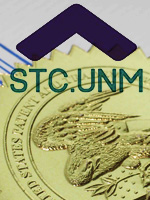Recent News
CHTM Joins NSF's NQVL Pilot Projects
August 9, 2024
OSE PHD, Dr. Xuefeng Li - Wins The Outstanding Interdisciplinary Graduate Programs Award
May 10, 2024
Dr. Ali Rastegari - 2024 OSE Best Dissertation Award Winner
May 10, 2024
2024 OSE Spring and Summer Graduates
May 10, 2024
News Archives
CHTM leads UNM departments and centers in patent list for fourth quarter of 2016
January 23, 2017 - Compiled by CHTM

The U.S. Patent & Trademark Office (USPTO) issued nineteen patents to the UNM Science & Technology Corporation (STC) during October, November and December of 2016 for a variety of technologies created by researchers in the centers and departments of the Center for High Technology Materials, Department of Pharmaceutical Sciences, Department of Electrical & Computer Engineering, Department of Biological & Chemical Engineering, Department of Computer Science, Department of Molecular Genetics & Microbiology, UNM Comprehensive Cancer Center, Department of Pathology, Department of Civil Engineering, and Center for Biomedical Engineering.
Six of these patents were issued to CHTM inventors.
Visit the original story at STC.UNM for the complete list of patents and the UNM academic departments which contributed to the research.
See the CHTM patent reports for:
• April-September, 2016
• January - March, 2016
CHTM inventors are featured on these patents:
2016 – October, November, December
Issued Patent for Cubic Phase, Nitrogen-Based Compound Semiconductor Films
Patent No. 9,461,112, issued October 4, 2016
Inventors: Seung-Chang Lee, Steven R. J. Brueck
This technology is a unique method and device for the epitaxial growth of cubic phase, nitrogen-based compound semiconductor thin films on a Si substrate which is periodically patterned with nanoscale grooves terminated in <111> sidewalls. The structure symmetry forces the growth of epitaxial, cubic-phase material within each groove. These initial growth nuclei can be extended to macro-scale islands sufficient for device fabrication or coalesced with the films grown from adjacent grooves to form a continuous film. This results in a wide-area, cubic phase nitrogen-based compound semiconductor film on a Si substrate.
Issued Patent for Surface Plasma Wave Coupled Detectors
Patent No. 9,466,739, issued October 11, 2016
Inventors: Steven R. J. Brueck, Sanjay Krishna, Seung-Chang Lee
This technology is a surface-plasma, wave-coupled detector consisting of binding a high- index layer above a low-index layer to confine the surface plasma wave mode. This type of structure helps to maximize absorption in the active detector medium with minimized contact resistance, as well as eliminates leaky mode characteristics which can lead to a drop in absorption.
Issued Patent for Method and System for Feature Extraction and Decision Making from Series of Images
Patent No. 9,471,974, issued October 18, 2016
Inventors: Sanjay Krishna, Sanchita Krishna, Majeed M. Hayat, Pradeep Sen, Maziar Yaesoubi, Sebastian Eugenio Godoy, Ajit Vijay Barve
This technology is a complete imaging and analysis system for the detection of skin cancer that can offer doctors and medical technicians an entirely passive, non-intrusive, way of detecting skin cancer. This concept is based on the principle that healthy tissue has different thermal properties than diseased tissue and by examining these differences, the system developed will give doctors a better idea of whether the abnormality is or is not malignant. This system is comprised of six stages which work together for proper functioning of the entire system. The most relevant part of such a technology is the procedure and methodology that enables the decision making from images acquired by the proposed imaging system.
Issued Patent for WGM-based Molecular Sensors
Patent No. 9,482,608, issued November 1, 2016
Inventors: Ravinder Jain, Mani Hossein- Zadeh
This technology is a novel method for ultrasensitive detection of trace molecules. This method proposes a device based on combining attenuation and unique phase properties along with the whispering gallery mode behavior in high-Q and infrared microresonators to permit ultrasensitive molecular sensors that are much easier to implement than those based on similar technology in the past.
Issued Patent for Spatio-Temporal Tunable Pixels ROIC for Multi-Spectral Imagers>br />Patent No. 9,521,346, issued December 13, 2016
Inventors: Glauco Rogerio Cugler-Fiorante, Payman Zarkesh-Ha, Sanjay Krishna
This technology is a novel 96 × 96 30 µm pitch mixed-signal ROIC, with a pixel-level tunable bias control. It is capable of providing a large bias voltage, in both polarities, on each individual pixel independently. Along with developing this innovative ROIC, the inventors have developed a FPGA-based test bench to control, test and characterize the new ROIC system, which already allows the FPA-ROIC to work as an autonomous IR detector and image processing system. This is an essential feature for portable applications. The ROIC has several applications in sensor technology, including infrared retina, classification cameras, and remote sensing imagers.
Issued Patent for Growth of Cubic Crystalline Phase Structure on Silicon Substrates and Devices Comprising the Cubic Crystalline Phase Structure
Patent No. 9,520,472, issued December 13, 2016
Inventors: Steven R. J. Brueck, Seung-Chang Lee, Christian Wetzel, Theeradetch Detchprohm, Christoph Stark
This technology combines metal-organic chemical vapor deposition (MOCVD) with large area nanoscale interferometric lithography to grow and fabricate LEDs using cubic GaN materials incorporating InxGa1-xN quantum wells grown on patterned Si (100) substrates.
Issued Patent for Methods to Introduce Sub-Micrometer, Symmetry-Breaking Surface Corrugation to Silicon Substrates to Increase Light Trapping
Patent No. 9,530,906, issued December 27, 2016
This technology is currently optioned / licensed.
Inventors: Sang Eon Han, Brittany R. Hoard, Sang M. Han, Swapnadip Ghosh
This technology is a method for producing sub-micrometer, symmetry-breaking periodic surface corrugation on silicon (Si) substrates using wet chemistry for etching. \These methods are simple, cost effective and eliminate the need to use off-cut substrates. Conventional lithography as well as roll-to-roll nanoimprint techniques can be used to fabricate a variety of etch templates that serve as a mask during chemical etching of the Si surface. Such symmetry-breaking surface corrugation would improve light trapping and substantially increase the efficiency of Si-based solar cells.


